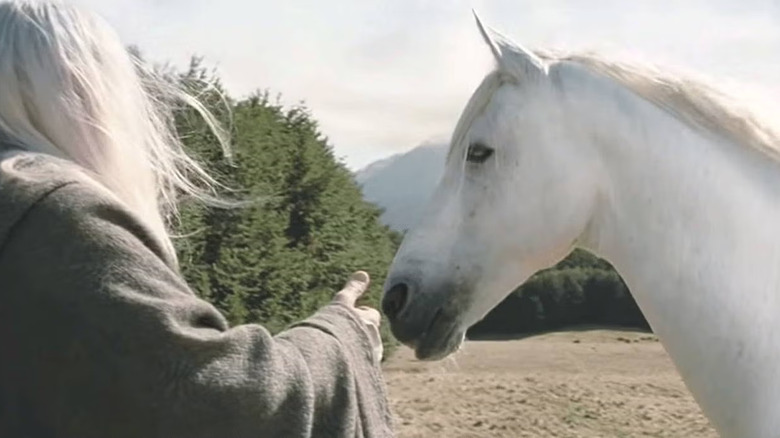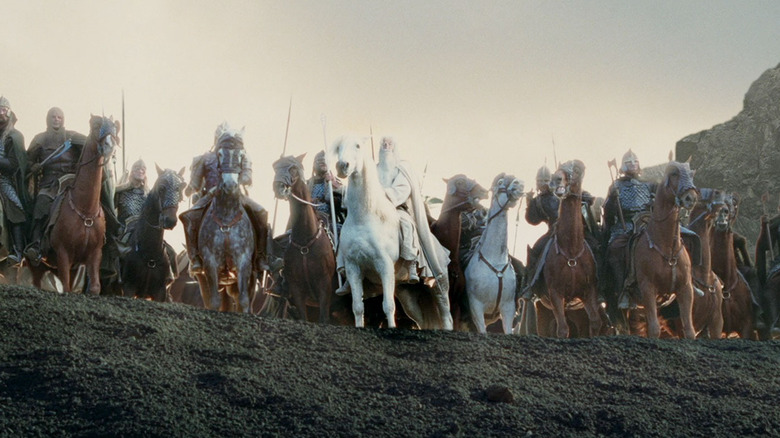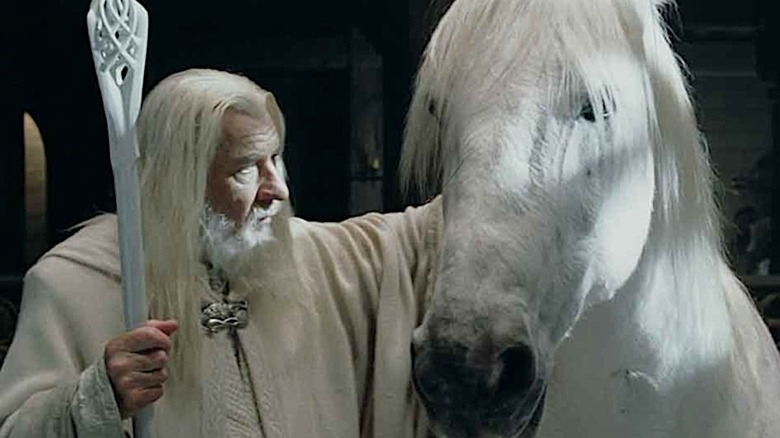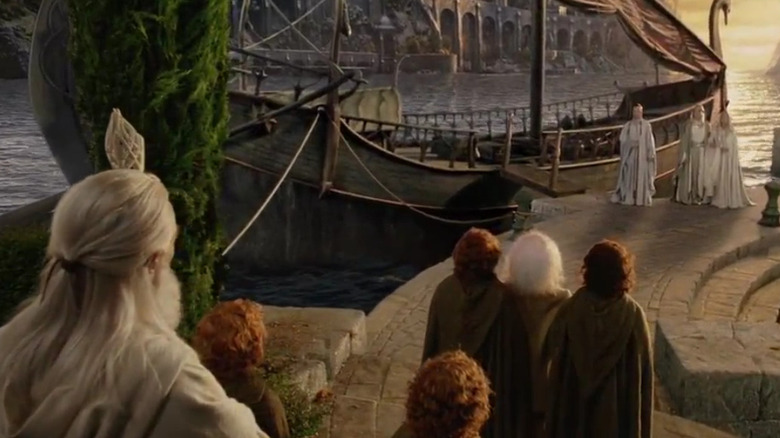Shadowfax: The Name Of Gandalf’s Horse Is Deeper Than Lord Of The Ring Fans Think
J.R.R. Tolkien was a fan of horses, and he wove them generously into his writings. While there are particularly impressive legendary horses that pop up from time to time during the events of “The Lord of the Rings,” there is one clear equine that stands out from the herd: Shadowfax. The white and silver horse of Rohan connects with the Wizard early in “The Lord of the Rings,” and the two go through the bulk of the War of the Ring together.
While Shadowfax’s role in the story is straightforward, his name isn’t. Fortunately, as with most things Tolkien, the Oxford professor left plenty of bread crumbs and bite-size explanations to translate the horse-lord’s title. (More on Shadowfax’s status as an equine leader in a minute.) In the book “The Lord of the Rings: A Reader’s Companion,” authors Wayne Hammond and Christina Scull gather these tidbits and break down Shadowfax’s nomenclature, explaining that it is an anglicized form of Rohan’s speech, which reads similar to Old English.
The book also includes the translation, “Sceadu-fæx ‘having shadow-grey mane (and coat).” It elaborates that the word “fax” is an obsolete English word for hair but is still used in Iceland and Norway. Using fax to mean hair or mane, the name would also translate as “Shadow Mane.”
The appellation is appropriate. The more you get to know Shadowfax in Tolkien’s writings, the more you realize he’s a perfect fit for a dream-like, adumbral title. Don’t believe us? Let’s dig into the backstory here, shall we?
What is the background to Shadowfax’s name?
Tolkien was never a man to half-heartedly name his characters. He would provide thoughtful, translatable names built on genuine linguistic foundations. Heck, in his forward to the Second Edition of “The Fellowship of the Ring” book, Tolkien explained that he didn’t think people would like “The Silmarillion,” saying, “especially since it was primarily linguistic in inspiration and was begun in order to provide the necessary background of ‘history’ for Elvish tongues.” Yeah, this guy was intense.
When it came time to name the horses of Rohan, Tolkien turned to the legendary languages of Northern Europe for inspiration. In an essay from The Tolkien Society titled the Tolkien’s Equestrian Epic, the academically-minded fan group explains, “The names Shadowfax and Snowmane [Théoden’s horse] relate to Icelandic names of legendary horses such as Hrimfaxi, a name meaning ‘Frosty mane’ from ‘hrim’, ‘frost’ and ‘faxi’, ‘mane’.” Shortly after this, the paper adds, “Icelandic legend has other horses with similar names, such as Freyfaxi – Frey’s black-maned stallion.”
Shadowfax may sound cool on the surface — and don’t get us wrong. It is! But as with all things Tolkien, the title is much deeper than it looks. It is part of who Shadowfax is and what he’s known for. In “The Two Towers” book, Gandalf (who also has an interesting name and meaning) reflects this truth, saying, “Does he not shine like silver, and run as smoothly as a swift stream?” Later in the book, Éomer also says of Shadowfax, “Were the breath of the West Wind to take a body visible, even so would it appear.” Translation: Shadowfax’s name isn’t random. It pairs with his super-equine abilities and otherworldly speed.
Shadowfax is a prince of horses and a bigger deal than you think
Shadowfax isn’t just a cool horse that befriends Gandalf. Peter Jackson’s movies may have been light on the details, but in “The Two Towers,” Tolkien goes in-depth on the fascinating history of Shadowfax and the horses of Rohan. In that book, when Aragorn, Legolas, and Gimli meet Shadowfax for the first time, Gandalf explains, “He is the chief of the Mearas, lords of horses, and not even Théoden, King of Rohan, has ever looked on a better.” A bit later in the book, Théoden himself refers to Shadowfax as the “prince of horses,” with the Rohirric king describing the horse thusly: “There is none like to Shadowfax. In him one of the mighty steeds of old has returned. None shall return again.”
In the appendices of “The Return of the King,” Tolkien explains the origin of the Mearas (at least as far as they intersect with the history of Men). The author cryptically hints that legends claim the Mearas originate in the Blessed Realm in the West. Their Middle-earth story starts with Théoden’s ancestor, Eorl, the first King of Rohan. When Eorl’s father, a horse tamer, is killed by a horse, he chases down and tames the beast through pure willpower, naming him Felaróf.
The text says, “Eorl rode him home without bit or bridle; and he rode him in like fashion ever after. The horse understood all that men said, though he would allow no man but Eorl to mount him.” Shortly after, it adds, “These were the mearas, who would bear no one but the King of the Mark or his sons, until the time of Shadowfax.” (And even then, Gandalf still rides Shadowfax without a bit or bridle.)
How do Gandalf and Shadowfax meet in the books?
During the Council of Elrond in “The Fellowship of the Ring” book, Gandalf explains how he and Shadowfax meet for the first time. The encounter comes after his escape by Eagle from Saruman’s tower of Orthanc. The movies imply that the Wizard rides his winged companion straight back to Frodo and company, but that isn’t the case. The book tells us that Gandalf asks the Eagle, Gwaihir the Windlord, how far he can bear him, and Gwaihir replies, “Many leagues, but not to the ends of the earth. I was sent to bear tidings not burdens.” Gandalf then says that he needs a horse, adding, “and a steed surpassingly swift, for I have never had such need of haste before.”
Gwaihir drops the Wizard off in Rohan, where Gandlaf already finds evil at work and Théoden poisoned against him thanks to the machinations of Wormtongue. At that point, Gandalf says, “He bade me take a horse and be gone; and I chose one much to my liking, but little to his. I took the best horse in his land, and I have never seen the like of him.” The name of that horse? Shadowfax.
Gandalf and Shadowfax hit it off and become best buds. The horse lord carries Gandalf all across northern Middle-earth at breakneck speed as they attempt to find the Ring-bearer. When they part, Gandalf tells the council, “I sent [Shadowfax] back to his master; but a great friendship has grown between us, and if I have need he will come at my call.”
What happens to Shadowfax after Lord of the Rings?
Once we get to the “Two Towers” storyline, Gandalf comes back as Gandalf the White. He reconnects with Shadowfax in the horse’s home country, where, in the book, the Wizard says, “Far let us ride now together, and part not in this world again!” The Wizard and the horse remain inseparable as Gandalf heals King Théoden and together, the pair of besties help rid Rohan of invaders.
After that, they stick together throughout the rest of the War of the Ring. In fact, the two become so inseparable that the reincarnated Gandalf becomes known as the White Rider. Shadowfax accompanies Gandalf to the war in Gondor and even to the Black Gate. After Sauron falls and Aragorn is restored to his throne, Gandalf and Shadowfax travel with the four Hobbits all the way home — or at least most of the way home. On their way from Bree to the Shire, Gandalf abruptly splits off from the Hobbits, leaving them to head off and free their homeland from Sauron’s minions (the “happily ever after” homecoming is one of the movie changes Peter Jackson made).
When they part ways, Gandalf and Shadowfax head off to visit the enigmatic Tom Bombadil and his wife Goldberry (two more casualties of Jackson’s adaptation). It isn’t until Frodo and Bilbo sail off into the West at the Grey Havens that Gandalf and Shadowfax appear again. They take the same ship as the Hobbit ring-bearers, sailing over the Sundering Seas, never to be heard or seen again in Middle-earth.






